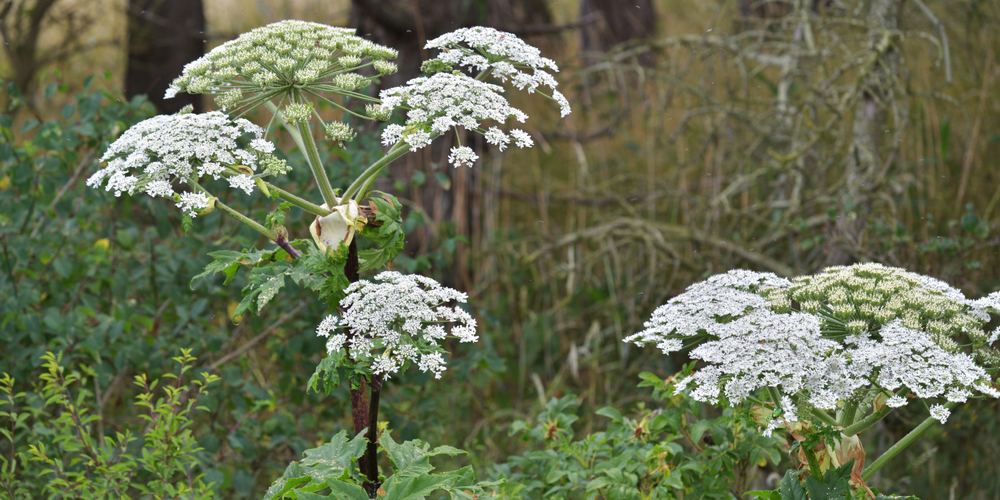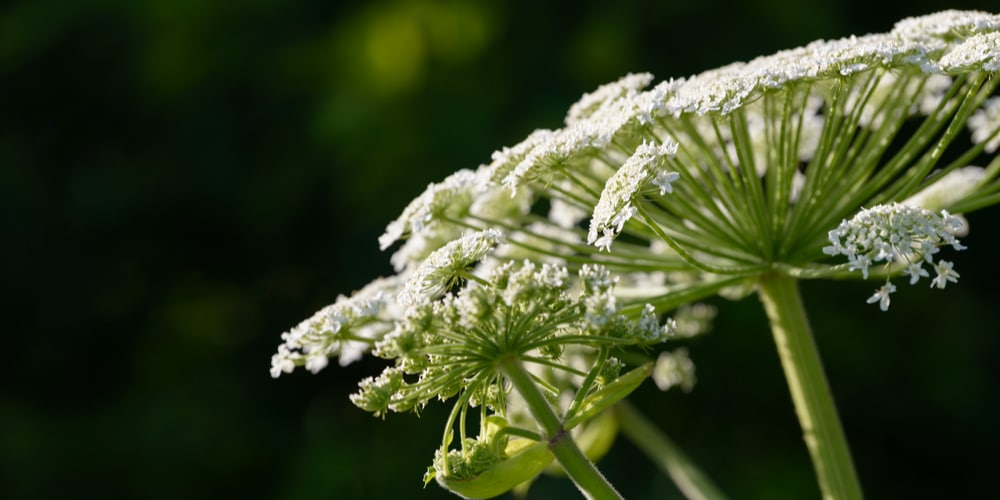Giant hogweed may look pretty at a distance, but this invasive plant contains poisonous sap that causes burns and scarring. It can be dangerous to those at risk. Thankfully, experts locate hogweed only in particular regions of the United States. Where does hogweed grow, and what should you do if you come in contact with it?
What Is Hogweed?
Giant hogweed is an invasive plant related to the carrot family. This herb grows incredibly tall – up to 14 feet or higher. Its long stems are hollow inside with many outer ridges. Hogweed stems are green and covered with distinct plum-colored patches.
Hogweeds grow clusters of small white flower heads. Together, these clusters can end up almost three feet wide. Aside from flowers, hogweed produces giant compound leaves, meaning several leaflets grow on a single stem.
Several other wild plants are giant hogweed lookalikes, such as:
- Cow parsnip
- Queen Anne’s lace
- Water hemlock
- Poison hemlock
Where Is Hogweed Native?
If you’re wondering where does hogweed grow, giant hogweed is an invasive plant in many countries, including the United States. An invasive species is something that is introduced and spreads throughout a nonnative area, causing potential harm to humans and the local environment.
The hogweed plant is native to central and southwest Asia, specifically the Caucasus Mountain region between the Black and Caspian Seas.
By the twentieth century, hogweed spread to Europe and the U.S. for a few hypothesized reasons. The giant plant’s size impressed many travelers. They took seeds back with them and used hogweed for decorative purposes.
Migratory animals like birds also distributed hogweed seeds out of their native territory, and the plants began growing afterward.
Where Can Hogweed Grow in the U.S.?
People report seeing the highest concentrations of giant hogweed clusters in the Northeast and Northwest regions and states around the Great Lakes. So far, hogweed is invasive to over 15 states, including:
- Maine
- Maryland
- Michigan
- New Hampshire
- Ohio
- Oregon
- Pennsylvania
- Vermont
Some people even report seeing hogweed in southern states like Virginia.
Within these states, people spot hogweed in open areas with damp soil and a lot of sunlight. This plant prefers growing along roadsides, rivers, and streams. You may also see giant hogweed in fields, forested areas, and possibly your backyard.
Is Hogweed Dangerous?
Though some people think hogweed is pretty, hogweed is dangerous for people, the environment, and other animals and pets.
Since giant hogweed is an invasive species in the U.S., it threatens the environment. Invasive plants could cause other native plants to go extinct. Animals and other wildlife that rely on native plants for survival are then vulnerable.
When invasive plants like hogweed take over an area, this limits biodiversity and alters the land, resulting in potentially enormous changes for ecosystems.
Giant hogweed is also poisonous to humans, causing dangerous side effects. However, since the plant is so large, it is easier to avoid than other harmful plants like poison ivy.
What Happens if You Touch Hogweed?
If you come into contact with hogweed, your skin will likely have some degree of an allergic reaction. Washing the area with warm soapy water as soon as possible may help alleviate the severity of the symptoms. Covering the affected area from sunlight can reduce any reaction.
Giant hogweed is harmful to humans because of its sap. Contact with this plant’s sap has serious side effects that increase your skin’s sensitivity to sunlight. Hogweed sap can also cause harsh burns and even blindness.
Most reactions occur within a week of contact with giant hogweed. Typical symptoms include:
- Rashes
- Burns
- Blisters
- Increased sun sensitivity
Skin damage from giant hogweed takes a while to heal. Lasting effects like hypersensitivity to the sun may last a lifetime. In rare cases, people may develop phytophotodermatitis from contact with hogweed, a skin condition triggered by sunlight exposure with limited treatment options.
How Can I Remove Hogweed From My Yard?
If you suspect that giant hogweed is in your yard, do not touch the plant without proper protection. Most experts do not advise removing the plant on your own. Instead, report the sighting to your state’s department of conservation. They will help you properly control the spread.
When dealing with hogweed on your property, here are a few precautions to decrease your likelihood of a dangerous reaction:
- Never touch hogweed with uncovered skin
- Wear sunscreen
- Immediately wash any clothes that may have touched the plant
- Scrub all work equipment after using
- Never use a weed-eater on hogweed; the sap might spray as a result
- Work after sunset to avoid sun exposure
Cover up as much skin as possible. Wear long sleeves, pants, boots, and long gloves. Use glasses or some form of eye protection. Wearing water-resistant clothing is best because it deflects the hogweed sap.

